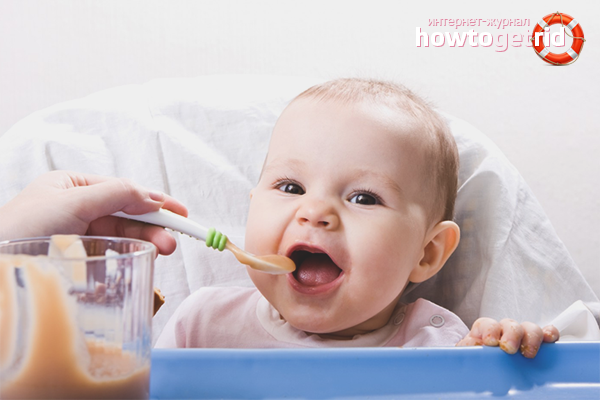The content of the article
The digestive system of an infant up to 5-6 months only accepts breast milk and special mixtures. Adult foods cause bloating, indigestion, and constipation in a child. If the baby grows and develops quickly, does not complain about well-being and is gaining the required kilograms, the first feeding is introduced at 6-7 months or a little later. And you do not need to listen to grandmothers who are trying to stuff a cutlet or juice into a newborn.
Products for the small tummy
The stomach of a six-month-old child is poorly absorbed by complex dishes consisting of several components. Indigestion causes sausage, meatballs, fried meat and even freshly squeezed fruit juice. Pediatricians are advised to use simple and dietary foods for feeding:
- vegetables;
- seasonal fruits;
- cereals;
- dairy products.
Porridge for baby
Children who are poorly gaining weight are given cereals boiled in water or mother's milk. Useful foods in which add a spoonful of dry mix. You can’t fill the dish with oil or sour cream. The kid can be treated to:
- rice
- buckwheat;
- corn porridge.
Wheat, barley, oatmeal and barley are contraindicated. Cereals contain gluten - a complex protein that can cause an allergy and inflammation of the small intestine in a child. Cereal cereals are prepared for babies older than 7-8 months. They have enough enzymes in the body to digest and absorb oatmeal or barley.
Start with buckwheat. The product contains iron, phosphorus and potassium. Rice porridge should not be given to babies, who often have constipation. Selected cereals are boiled in water without spices and seasonings. Salt, butter or sugar is not added. Rub the porridge with a blender or using a sieve to make a liquid mucous paste without lumps.
Vegetable Puree
Vegetables are recommended for children prone to flatulence. The dish for the first feeding is prepared from zucchini, cauliflower or broccoli. Potatoes are contraindicated. It contains starch. The digestive system of the child does not absorb this component.
Vegetable complementary foods are useful for children with excess and normal weight. Mashed squash or broccoli has a lot of fiber and a minimum of calories. Dietary fibers normalize the work of the stomach and intestines, accelerate metabolism.
Babies who are familiar with green and white vegetables are given mashed carrots or pumpkins. Kohlrabi and parsnips are offered, and at 8–9 months they are treated to boiled potatoes.
A complementary meal is prepared from one component to choose from. The product is boiled without salt and sugar. Knead with a fork, can be chopped in a blender. Busy mothers who do not have time for a double boiler and zucchini are advised to buy ready-made baby purees. Choose options for the first feeding, which do not include:
- ascorbic acid;
- starch;
- lemon juice;
- rice or corn flour.
Supplements can trigger an allergic reaction, and parents will not even realize that starch is to blame, not pumpkin or broccoli. Quality puree consists of only two components: vegetables and water. A store or homemade dish does not need to be salted. Children's food should be fresh, because the child’s stomach is not ready for spices and herbs.
The baby is given one vegetable for two weeks. Then they introduce a new product. If the child’s body has normally taken pumpkin and carrots, after 1–1.5 months, you can cook stew or diet soup without dressing.
Dairy products
Natural yogurt and kefir remind mother milk in composition. Sour-milk drinks infect the intestines of the baby with beneficial bacteria that help digest other foods.They are recommended for dysbiosis, colic and a tendency to flatulence.
Some pediatricians advise starting lure with cottage cheese. The baby is given a grated product without fruits and sugar. The baby quickly gets used to the sweet food and then refuses fresh vegetables and cereals. Cottage cheese can not be seasoned with sour cream. A fatty product can cause indigestion.
From 8 months old, homemade feta cheese and soft cheese are introduced into the diet of the baby. With 10 whole cow or goat milk.
Fruit for babies
Citruses and bananas are contraindicated in babies up to 1–1.6 years old. Seasonal fruits are useful for babies: pears, green apples, plums. Sweet mashed potatoes will appeal to capricious children who refuse cereals and vegetables. There are a lot of vitamins and fiber in foods. Fruit feeding is useful for babies who often catch a cold.
First, the child is given green apples. Peel the raw fruits and grind the flesh with a blender. If the baby’s stomach has normally accepted the new product, you can experiment with pears, but you can’t mix them with apples.
For babies up to a year, packaged and freshly squeezed juices are contraindicated. They are poorly absorbed and cause diarrhea. Half-year-old babies should not be treated with strawberries, too sweet peaches or apricots.
Meat and fish
From 7-8 months, chicken or rabbit is introduced. Pork is too heavy and takes a long time to digest, causing flatulence. Fatty meat is contraindicated in overweight infants.
The child is given to try meatballs or soufflé from beef, boiled turkey. Meat dishes can be mixed with cereals or mashed potatoes so that they are better digested.
From 8–9 months, infants are introduced to marine fish. Only low-fat varieties are prepared for the baby, the fillet is thoroughly cleaned of bones. Seafood is contraindicated, because they belong to the group of strong allergens. At this age, you can give an egg yolk. Boiled chicken or quail eggs are useful. The child is treated to a small piece the size of a pea. Sometimes the yolk is ground with cereal.
The meat and fish are cooked, it is necessary to grind it so that the baby does not choke. Whole pieces can be given when the child has teeth, and he learns to chew fruits and vegetables.
Pedagogical and pediatric complementary foods
A baby who has learned to hold his head is seated at a table with his parents. The child watches as mom and dad have breakfast and dinner, and begins to become interested in adult food. The kid is given a plastic spoon or other safe item in his hands, so that he plays and gets used to cutlery.
Fans of pedagogical feeding treat infants with soup from their own plate when he shows interest in the dish. If parents decide to introduce complementary foods in this way, they will have to give up fried, greasy foods and foods that can cause allergies. It is advised to switch to cereal, vegetable stew or cottage cheese.
You can put a plate in front of the child on which pieces of pepper, carrot and beetroot are laid out. Boil vegetables or pour boiling water to make them softer. The baby chooses what product he wants to chew on his own. You can add a bunch of parsley or dill to beets and peppers.
Pedagogical feeding has several disadvantages:
- Kids do not know how to chew solid foods. A child choking on a piece of potato for a long time refuses adult dishes.
- Soups and stews contain several ingredients. It is difficult for parents to determine which component caused allergies and diarrhea.
- Not all dishes that mothers and grandmothers eat are useful for babies.
Supporters of pediatric complementary foods prepare special one-component dishes for the baby. They independently decide which product the baby will eat for a week. Mom forbids the child to climb into a plate with adult food and never treats him with his soup or porridge.
Parents who choose pediatric complementary foods are advised to have a special notebook or notebook.This will be the magazine of the baby, in which the mother writes down dishes, portion sizes and the reaction of the child's body. It’s easier to keep track of which products your baby tolerates normally and which ones to refuse.
Important: Breast need to be interested in adult food. You can not force a child to eat zucchini puree or buckwheat porridge if he refuses and protests. If you force food into your baby, he will have an aversion to anything that tastes different from breast milk.
Fundamental rules
Nutrient supplementation is administered when the baby's reflex reflex disappears. How to understand that the time has come? The kid is trying to chew gums a piece of apple or carrot. He drinks water from a spoon and does not push all the liquid back. The child does not have a gag reflex after 5 g of mashed potatoes or porridge.
The baby is first offered a spoon of complementary foods, and then a breast or a bottle with the mixture. A well-fed baby usually refuses unfamiliar products, and a hungry one agrees to try.
A new dish is given to the child in the morning. If complementary foods do not fit, symptoms will appear after a few hours:
- rash or blisters;
- redness on the cheeks;
- swollen belly;
- flatulence and colic;
- diarrhea or constipation;
- mucus or strange impurities in the feces.
Throughout the week, the child is treated to one of the zucchini puree or buckwheat porridge. If the body normally took the dish, go to the next product.
A baby who first tastes adult food is first given a half teaspoon. Serving size increases 1.5–2 times daily.
Feed the baby only with a spoon, no bottles or syringes. The product must be mixed with saliva. It contains enzymes that facilitate the digestion of food.
Does the baby have an allergy or flatulence due to broccoli or rice? The product is removed from the diet, the baby is fed only breast milk for a week, so that the body has time to recover. When the symptoms disappear, the crumbs offer another dish.
Vegetable and fruit foods provide the body with vitamins and fiber. Sour-milk products improve the intestines, and cereals make the baby strong and healthy. But any, even the most delicious and healthy complementary foods, will not replace mother's milk, so women are advised to breastfeed the baby for up to a year or even two years.
Video: what time to start feeding babies












Submit